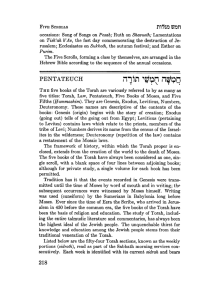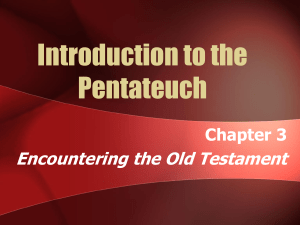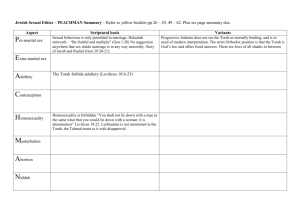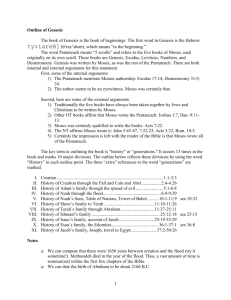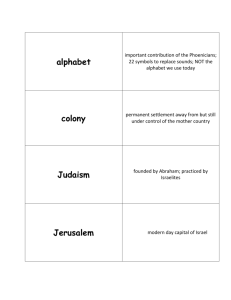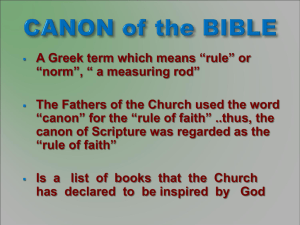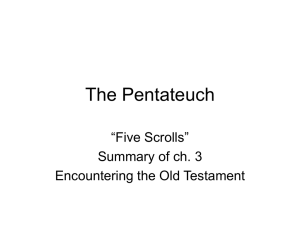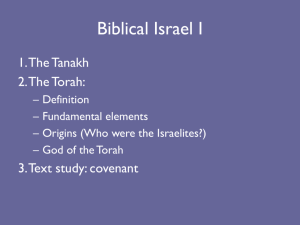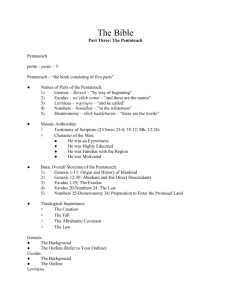Documentary Hypothesis
advertisement
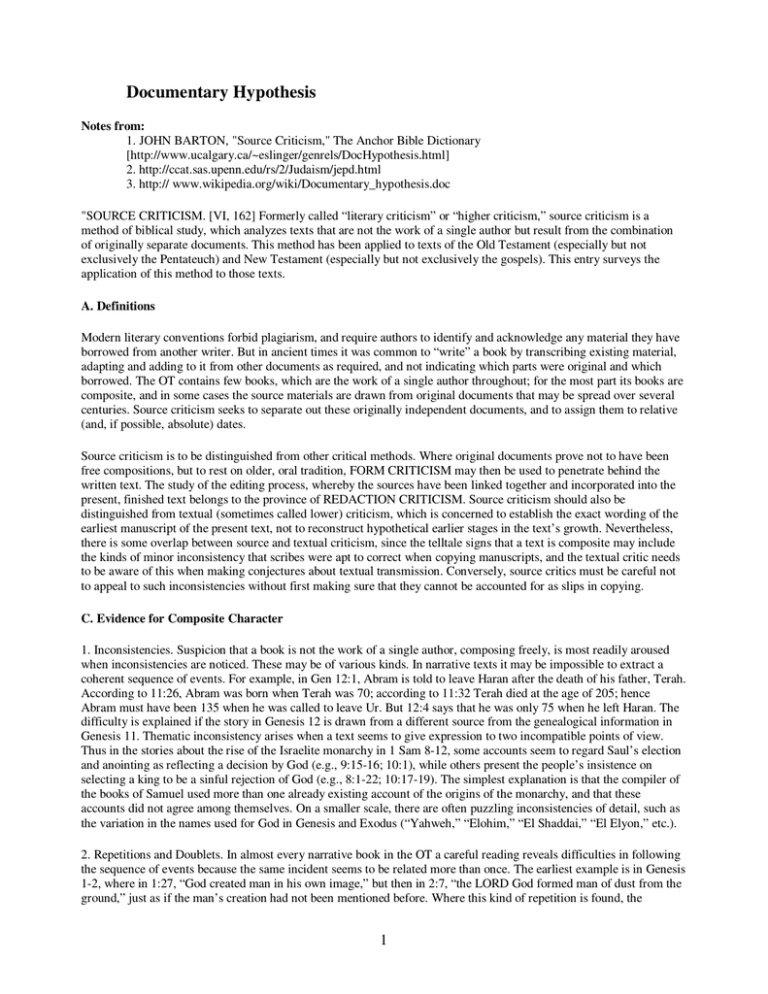
Documentary Hypothesis Notes from: 1. JOHN BARTON, "Source Criticism," The Anchor Bible Dictionary [http://www.ucalgary.ca/~eslinger/genrels/DocHypothesis.html] 2. http://ccat.sas.upenn.edu/rs/2/Judaism/jepd.html 3. http:// www.wikipedia.org/wiki/Documentary_hypothesis.doc "SOURCE CRITICISM. [VI, 162] Formerly called “literary criticism” or “higher criticism,” source criticism is a method of biblical study, which analyzes texts that are not the work of a single author but result from the combination of originally separate documents. This method has been applied to texts of the Old Testament (especially but not exclusively the Pentateuch) and New Testament (especially but not exclusively the gospels). This entry surveys the application of this method to those texts. A. Definitions Modern literary conventions forbid plagiarism, and require authors to identify and acknowledge any material they have borrowed from another writer. But in ancient times it was common to “write” a book by transcribing existing material, adapting and adding to it from other documents as required, and not indicating which parts were original and which borrowed. The OT contains few books, which are the work of a single author throughout; for the most part its books are composite, and in some cases the source materials are drawn from original documents that may be spread over several centuries. Source criticism seeks to separate out these originally independent documents, and to assign them to relative (and, if possible, absolute) dates. Source criticism is to be distinguished from other critical methods. Where original documents prove not to have been free compositions, but to rest on older, oral tradition, FORM CRITICISM may then be used to penetrate behind the written text. The study of the editing process, whereby the sources have been linked together and incorporated into the present, finished text belongs to the province of REDACTION CRITICISM. Source criticism should also be distinguished from textual (sometimes called lower) criticism, which is concerned to establish the exact wording of the earliest manuscript of the present text, not to reconstruct hypothetical earlier stages in the text’s growth. Nevertheless, there is some overlap between source and textual criticism, since the telltale signs that a text is composite may include the kinds of minor inconsistency that scribes were apt to correct when copying manuscripts, and the textual critic needs to be aware of this when making conjectures about textual transmission. Conversely, source critics must be careful not to appeal to such inconsistencies without first making sure that they cannot be accounted for as slips in copying. C. Evidence for Composite Character 1. Inconsistencies. Suspicion that a book is not the work of a single author, composing freely, is most readily aroused when inconsistencies are noticed. These may be of various kinds. In narrative texts it may be impossible to extract a coherent sequence of events. For example, in Gen 12:1, Abram is told to leave Haran after the death of his father, Terah. According to 11:26, Abram was born when Terah was 70; according to 11:32 Terah died at the age of 205; hence Abram must have been 135 when he was called to leave Ur. But 12:4 says that he was only 75 when he left Haran. The difficulty is explained if the story in Genesis 12 is drawn from a different source from the genealogical information in Genesis 11. Thematic inconsistency arises when a text seems to give expression to two incompatible points of view. Thus in the stories about the rise of the Israelite monarchy in 1 Sam 8-12, some accounts seem to regard Saul’s election and anointing as reflecting a decision by God (e.g., 9:15-16; 10:1), while others present the people’s insistence on selecting a king to be a sinful rejection of God (e.g., 8:1-22; 10:17-19). The simplest explanation is that the compiler of the books of Samuel used more than one already existing account of the origins of the monarchy, and that these accounts did not agree among themselves. On a smaller scale, there are often puzzling inconsistencies of detail, such as the variation in the names used for God in Genesis and Exodus (“Yahweh,” “Elohim,” “El Shaddai,” “El Elyon,” etc.). 2. Repetitions and Doublets. In almost every narrative book in the OT a careful reading reveals difficulties in following the sequence of events because the same incident seems to be related more than once. The earliest example is in Genesis 1-2, where in 1:27, “God created man in his own image,” but then in 2:7, “the LORD God formed man of dust from the ground,” just as if the man’s creation had not been mentioned before. Where this kind of repetition is found, the 1 simplest explanation is often that two versions of the same story have both been allowed to remain in the finished form of the book, unreconciled with each other. In some cases material from two or more sources seems to be interwoven: the classic example is the Flood Narrative of Genesis 6-9, where one version speaks of a 40-day flood and the other of a 150-day flood, with incidents from the two versions set down in alternating blocks. Similarly repetitious accounts, often extremely complex and hard to analyze, may be found in Exodus 24, where Moses seems to go up the holy mountain three times, and Joshua 3-4, in which the account of the crossing of the Jordan under Joshua’s leadership is impossibly convoluted. Where two accounts or versions are closely similar in extent, they are often called a doublet: compare, for example, 2 Kgs 24:10-14 with 24:15-16, or Gen 37:21-22 with 37:26-27. 3. Stylistic Differences. Some OT books show extraordinary variations of style, ranging from a preference for particular words or phrases to peculiarities of grammar and syntax. In the Pentateuch, variation is particularly marked in Genesis and Exodus, where some sections are written in a lively narrative style akin to that of the books of Samuel, while others are marked by a stylized and repetitive manner, full of recurring formulas, lists, and technical terms. Compare, for example, the vivid narrative of Exodus 2—the childhood and early career of Moses—with the ponderous accounts of the building and equipping of the tent sanctuary in Exodus 36-40. Such variations in style can also be found in poetic books. Among the oracles in Jeremiah, for example, there are some (e.g., chapters 30 and 31) whose similarity to the style of Isaiah 40-55 (the so-called “Second Isaiah”) is so close, and whose dissimilarity from the rest of Jeremiah is so great, that they seem likely to derive from a different hand than the rest of the book. Other chapters in Jeremiah, especially those in prose, seem close to the style of the Deuteronomistic History (Joshua-2 Kings). While an appreciation of stylistic difference is often to some extent subjective, the variations within books such as these are wide enough to make it unlikely that a single author is responsible for all the material. English translations of the Bible tend to flatten out such differences by using a uniform “biblical English,” but in the Hebrew they are easily detected. D. Stages of Source-Critical Analysis 1. Breaking Up the Text. Source-critical analysis begins not with a quest for continuous sources, but with an analysis, into fragments, of each section of the biblical book under consideration. The source critic must note each point where there is a break, inconsistency, or discontinuity in the text, and so establish for each chapter how many different pieces of underlying material are present. ... 2. Reconstructing the Sources. Though some books of the OT may have been assembled from a host of tiny fragments and so are little more than anthologies, this process of growth seems unlikely for most of the narrative books of the Bible. For example, when the fragments into which the Pentateuch has been analyzed are examined, they group themselves naturally into a few piles, each marked by a very strong family resemblance. Thus the creation story of Gen 2:4b-25, the account of the building of the tent in Exodus 36-40, and the laws of Leviticus have so many points of style, expression, and theology in common that they probably derive from the same document. ... Painstaking work along these lines resulted in the classic “four-source” hypothesis for the Pentateuch outlined above, according to which the whole work was assembled from only four underlying sources, three of them continuous, parallel accounts of the history of the world from creation to the death of Moses (J, E, P) and the fourth basically the book of Deuteronomy and some related narrative materials (D). Each of the four sources is marked by a uniform style, certain preferences of vocabulary and theme, and its own chronological framework. It is the unresolved clashes between the four, mutually incompatible presentations that make the Pentateuch so bewildering to the casual reader. See also YAHWIST (J) SOURCE; ELOHIST (E) SOURCE; PRIESTLY (P) SOURCE; DEUTERONOMY. Other books yield to the same kind of analysis. Thus scholars distinguish three or four basic kinds of material in Jeremiah, each of which may have had an independent existence as a self-contained work before being edited to produce the present book. 3. Dating the Sources. Relative dating of source-materials is sometimes possible, where it seems likely that one sourcedocument was written by someone already familiar with another. Thus, in the case of the Pentateuch, it is sometimes argued that the P narrative of the events at Sinai presupposes an acquaintance with the J version and therefore must be later. Where there is no such presumption, however, the relative dating of sources depends, like their absolute dating, on external points of reference. One of the oldest critical observations in biblical studies was that certain verses in the Pentateuch could not be by Moses, because they presupposed a far later period. Thus the statement, “The Canaanite was then in the land” (Gen 12:6), can only have been written by someone living after the Canaanites had ceased to be in the land, that is, long after Joshua. But it has only been since the triumph of critical biblical scholarship in the 19th century that such arguments have been applied rigorously to the whole OT, with the result that many sources can now be given, if not firm dates, at least a terminus post quem and a terminus ante quem—earliest and latest possible dates. 2 E. Terminology After the Enlightenment, scholars began to think of the Bible as a source in a different sense: as important historical evidence from which the history of Israel or of the early church could be reconstructed. This is the sense in which 19thcentury secular historians spoke of studying historical sources, meaning by this valuable primary documents; and when Wellhausen suggested that the Pentateuch consisted of four sources, he meant four sources for reconstructing the history of Israel and its institutions. If a history of Israel was to be written, it was essential to establish which were the primary sources of evidence—and the four-document hypothesis maintained that there were four such sources, rather than (as a superficial reading of the Pentateuch would suggest) only one. Modern usage has moved from saying that the Pentateuch contains four historical sources (of information) to saying simply that the Pentateuch consists of four sources, thereby losing contact with the original reason for using this particular term, and treating it simply as a synonym for “underlying literary document." Details of Documentary Hypothesis Literary analysis shows that one person did not write the Pentateuch. Multiple strands of tradition were woven together to produce the Torah. The view that is persuasive to most of the critical scholars of the Pentateuch is called the Documentary Hypothesis, or the Graf-Wellhausen Hypothesis, after the names of the 19th-century scholars who put it in its classic form. “Briefly stated, the Documentary Hypothesis sees the Torah as having been composed by a series of editors out of four major strands of literary traditions. These traditions are known as J, E, D, and P.” We can diagram their relationships as follows. J (the Jahwist or Jerusalem source) uses the Tetragrammaton as God' s name. This source' s interests indicate it was active in the southern Kingdom of Judah in the time of the divided Kingdom. J is responsible for most of Genesis. 3 E (the Elohist or Ephraimitic source) uses Elohim ("God") for the divine name until Exodus 3-6, where the Tetragrammaton is revealed to Moses and to Israel. This source seems to have lived in the northern Kingdom of Israel during the divided Kingdom. E wrote the Aqedah (Binding of Isaac) story and other parts of Genesis, and much of Exodus and Numbers. J and E were joined fairly early, apparently after the fall of the Northern Kingdom in 722 BCE. It is often difficult to separate J and E stories that have merged. D (the Deuteronomist) wrote almost all of Deuteronomy (and probably also Joshua, Judges, Samuel, and Kings). Scholars often associate Deuteronomy with the book found by King Josiah in 622 BCE (see 2 Kings 22). P (the Priestly source) provided the first chapter of Genesis; the book of Leviticus; and other sections with genealogical information, the priesthood, and worship. According to Wellhausen, P was the latest source and the priestly editors put the Torah in its final form sometime after 539 BCE. Recent scholars (for example, James Milgrom) are more likely to see P as containing pre-exilic material. Contemporary critical scholars disagree with Wellhausen and with one another on details and on whether D or P was added last. But they agree that the general approach of the Documentary Hypothesis best explains the doublets, contradictions, differences in terminology and theology, and the geographical and historical interests that we find in various parts of the Torah. Here are some differences between the four strands of tradition. J Jahwist E Elohist P Priestly D Deuteronomist stress on Judah stress on northern Israel stress on Judah stress on central shrine stresses leaders stresses the prophetic stresses the cultic stresses fidelity to Jerusalem anthropomorphic speech about God refined speech about God majestic speech about God speech recalling God' s work God walks and talks with us God speaks in dreams cultic approach to God moralistic approach God is YHWH God is Elohim (till Ex God is Elohim (till Ex 3) 3) God is YHWH uses "Sinai" Sinai is "Horeb" has genealogies and lists has long sermons Jewish tradition on the origin of the Torah The traditional Jewish view, still held by Orthodox Judaism today, holds that God revealed his will to Moses at Mount Sinai in a verbal fashion. This view is also held by many Christians, within most branches of Christianity. According to Jewish tradition, this dictation is said to have been exactly transcribed by Moses. The Torah was then exactly copied by scribes, from one generation to the next. Based on the Talmud (Tractate Gittin 60a) some believe that the Torah may have been given piece-by-piece, over the 40 years that the Israelites wandered in the desert. In either case, the Torah is considered a direct quote from God. However, there are a number of exceptions to this belief within Orthodox Judaism. • Over the millennia scribal errors have crept into the text of the Torah. The Masoretes (7th to 10th centuries CE) compared all extant variations and attempted to create a definitive text. Also, there are a number of places 4 in the Torah where it appears that there are gaps and it has been postulated that part of the text has been edited out. • Some phrases in the Torah present information that should only have been known after the time of Moses; s and Joseph Bonfils' s observation of this, some classical rabbis postulated that Based on Abraham ibn Ezra' these sections of the Torah were written by Joshua or perhaps some later prophet. Other rabbis would not accept this view. • The Talmud, in tractate Shabbat 115b, states that a peculiar section in the book of Numbers 10:35-36, surrounded by inverted Hebrew letter nuns, in fact is a separate book. On this verse a Midrash on the book of Mishle states that "These two verses stem from an independent book which existed, but was suppressed!" Another, possibly earlier midrash, Ta'ame Haserot Viyterot, states that this section actually comes from the book of prophecy of Eldad and Medad. • Deuteronomy is quite different in many ways from the previous four books. Commenting on this, the Talmud says that the other four books of the Torah were dictated by God, but Deuteronomy was written by Moses in his own words (Talmud Bavli, Megillah 31b). Some rabbis have noted that some other parts of the Torah may also have been composed this way as well. • For more information on these issues from an Orthodox Jewish perspective, see Modern Scholarship in the Study of Torah: Contributions and Limitations, edited by Shalom Carmy (Jason Aronson, Inc.) and Handbook of Jewish Thought, Volume I, by Aryeh Kaplan (Moznaim Pub.) Classical rabbinical views that suggest multiple origins The modern, critical view of the origin of the Torah is not without precedent. Within Jewish tradition, individual rabbis and scholars have on occasion pointed out that the entire Torah showed signs of not being totally written by Moses. • • • • • • Rabbi Judah ben Ilai held that the final verses of the Torah must have been written by Joshua. (This is discussed in the Talmud, Bava Batra 15a and Menachot 30a, and in Midrash Sifrei 357.], however Rabbi Shimon bar Yochai disagrees. Parts of the Midrash retains evidence of the redactional period during which Ezra redacted and canonized the text of the Torah as we know it today. A rabbinic tradition states that at this time (440 B.C.E.) the text of the Torah was edited by Ezra, and there were ten places in the Torah where he was uncertain as to how to fix the text; these passages were marked with special punctuation marks called the eser nekudot. In the middle ages, Rabbi Abraham ibn Ezra and others noted that there were several places in the Torah which apparently could not have been written in Moses' s lifetime. For example, see Ibn Ezra' s comments on Genesis 12:6, 22;14, Deuteronomy 1:2, 3:11 and 34:1,6. Ibn Ezra' s comments were elucidated by Rabbi Joseph Bonfils in his commentary on Ibn Ezra' s work. In the twelfth century, the commentator R. Joseph ben Isaac, known as the Bekhor Shor, noted that a number of wilderness narratives in Exodus and Numbers are very similar, in particular, the incidents of water from the rock, and the stories about manna and the quail. He theorized that both of these incidents actually happened once, but that parallel traditions about these events eventually developed, both of which made their way into the Torah. In the thirteenth century, R. Hezekiah ben Manoah (known as the Hizkuni) noticed the same textual anomalies that Ibn Ezra noted; thus R. Hezekiah' s commentary on Genesis 12:6 notes that this section "is written from the perspective of the future.". In the fifteenth century, Rabbi Yosef Bonfils while discussing the comments of Ibn Ezra, noted: "Thus it would seem that Moses did not write this word here, but Joshua or some other prophet wrote it. Since we believe in the prophetic tradition, what possible difference can it make whether Moses wrote this or some other prophet did, since the words of all of them are true and prophetic?" Internal textual evidence 5 Doublets and triplets are stories that are repeated with different points of view. Famous doublets include Genesis' s creation accounts; the stories of the covenant between God and Abraham; the naming of Isaac; the two stories in which Abraham claims to a King that his wife is really his sister; the two stories of the revelation to Jacob at Bet-El. A famed triplet is the three different versions of how the town of Be' ersheba got its name. There are many portions of the Torah, which seem to imply more than one author. Some examples include: • • • • • • • Genesis 11:31 describes Abraham as living in the Ur of the Chaldeans. But the Chaldeans did not exist at the time of Abraham. Numbers 25 describes the rebellion at Peor, and refers to Moabite women; the next sentence says the women were Midianites. Deuteronomy 34 describes the death of Moses. The list of Edomite kings included Kings who were not born until after Moses'death. Some locations are identified by names, which did not exist until long after the time of Moses. The Torah often says that something has lasted "to this day," which seems to imply that the words were written at a later date. Classical commentaries usually interpret such verses to mean until the day they are read, in other words forever. Deuteronomy 34:10 states "There never again arose a prophet in Israel like Moses..." which seems to imply that the verse was written long after. However, this can be understood as "There would never again arise.." The Documentary Hypothesis In 1886 the German historian Julius Wellhausen published Prolegomena zur Geschichte Israels (Prolegomena to the History of Israel). Wellhausen argued that the Bible is an important source for historians, but cannot be taken literally. He argued that the "hexateuch," (including the Torah or Pentateuch, and the book of Joshua) was written by a number of people over a long period of time. Specifically, he identified four distinct narratives, which he identified as Jahwist, Elohist, Deuteronomist and Priestly accounts. He also identified a Redactor, who edited the four accounts into one text. (Some argue the redactor was Ezra the scribe). He argued that each of these sources has its own vocabulary, its own approach and concerns, and that the passages originally belonging to each account can be distinguished by differences in style (especially the name used for God, the grammar and word usage, the political assumptions implicit in the text, and the interests of the author. • • • • The "J" source: In this source God' s name is always presented as YHVH, which German scholars transliterated as Jahweh (the equivalent of the English transliteration Jehovah). The "E" source: In this source God' s name is always presented as Elohim (Hebrew for God, or Power) until the revelation of Gods name to Moses after which God is referred to as YHVH. The "D" or "Dtr" source: The source that wrote the book of Deuteronomy, and the books of Joshua, Judges, I and II Samuel and I and II Kings. The "P" source: The priestly material. Uses Elohim and El Shaddai as names of God. Wellhausen argued that from the style and point of view of each source, one could draw inferences about the times in which the source was written (in other words, the historical value of the Bible is not that it reveals things about the events it describes, but rather that it reveals things about the people who wrote it). Moreover, Wellhausen argued that the progression evident in these four sources, from a relatively informal and decentralized relationship between people and God in the J account, to the relatively formal and centralized practices of the P account, one could see the development of institutionalized Israelite religion. The documentary understanding of the origin of the five books of Moses was immediately seized upon by other scholars, and within a few years became the predominant theory. While many of Wellhausen' s specific claims have since been dismissed, we must note that the documentary hypothesis is not one specific theory. Rather, this name is given to any understanding of the origin of the Torah that recognizes that there are basically four sources that were somehow redacted together into a final version. One could claim that one redactor wove together four specific texts, or one could hold that entire nation of Israel slowly created a consensus work based on various strands of the Israelite tradition, or anything in between. Gerald A. Larue writes "Back of each of the four sources lie traditions that may have been both oral and written. Some may have been preserved in the songs, ballads, and folktales of different tribal groups, 6 some in written form in sanctuaries. The so-called ' documents'should not be considered as mutually exclusive writings, completely independent of one another, but rather as a continual stream of literature representing a pattern of progressive interpretation of traditions and history." ("Old Testament Life and Literature" 1968) Acceptance of the Theory Some Jews and Christians reject the theory entirely, and follow the traditional view that the whole Torah is the work of Moses. Others, such as the translators of the New International Version take a middle ground, believing that Moses was the author of much of the text, and editor and compiler of the majority of the rest. Most critical bible scholars, however, accept the principle of multiple authorship, and Wellhausen' s identification of four basic accounts. Many, however, have questioned his interpretation of Israelite religion, including his reconstruction of the order of the accounts JEDP. Some scholars have questioned Wellhausen' s assumption that history follows a linear progression. They have suggested that he organized the narrative to culminate with P because he believed that the New Testament followed logically in this progression. In the 1950s the Israeli historian, Yehezkel Kaufmann, published The Religion of Israel, from Its Beginnings to the Babylonian Exile, in which he argued that the order of the sources would be J, E, P, and D. In recent years attempts have been made to separate the J, E, D, and P portions. Harold Bloom wrote "The Book of J", in which he claims to have reconstructed the book that J wrote (though, certainly, much of J' s original contribution must have been lost in the consolidation, if one believes the four-author theory). Bloom also indicates that he believes that J was a woman, but this is not accepted by other scholars. 7
